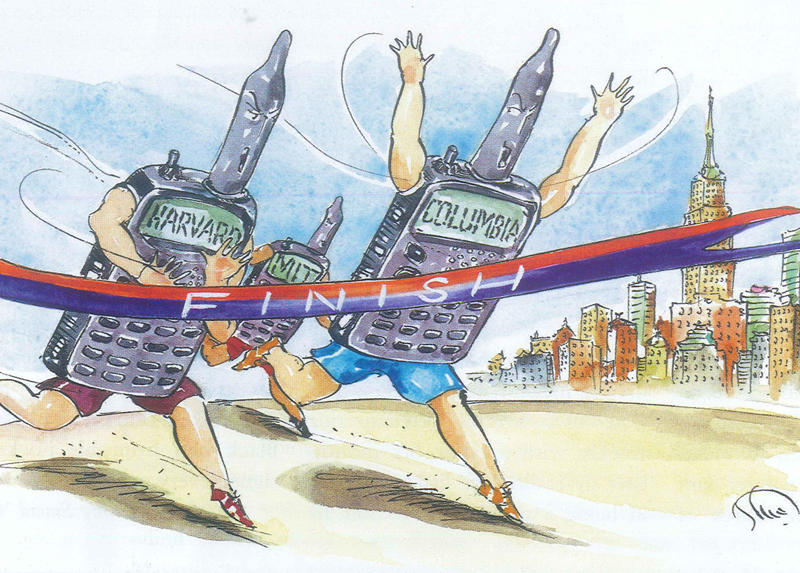When it comes to a race for first, few events are as competitive as the New York City Marathon. Alan Crosswell ’81SEAS, ’85SEAS should know. The associate vice president and chief technologist for Columbia University Information Technology, Crosswell spent last November 2nd helping marathon organizers to deal with logistical issues, report on any needs for supplies at the water and aid stations, and track runners who dropped out of the race so their families and friends could find them.
But Crosswell didn’t perform this public service with a cell phone or a computer or a BlackBerry. Rather, he made use of a private passion — his ham radio. Yes, ham radio, the hobby that famously occupied Barry Goldwater’s spare time back in the 1960s and 1970s, is still around. Gone, however, are the hulking racks of radio tubes, chromed switches, and Bakelite bezels. Instead, portable equipment as small as walkie-talkies increasingly does the trick. Crosswell was 1 of about 400 hams who worked the big race.
Little more than a century ago, during the infancy of radio technology, wireless pioneers such as Guglielmo Marconi were household names. Science magazines of both the popular and technical variety trumpeted this miraculous new ability to transmit dashes, dots, and even voice at a distance, and storybook serials like The Radio Boys wove strands of adventure and romance around an armature of copper, crystal, and solder. Today, despite the devouring appetite of the Internet, radio aficionados are still among us — including those at the Columbia University Amateur Radio Club (CUARC).
Enthusiasts can be found on quite a few campuses nationally (Columbia has an FCC charter for station W2AEE), and some of them take their hobby very seriously. This year, for instance, the Harvard Wireless Club is preparing to celebrate its centennial for what it claims is the nation’s oldest collegiate amateur radio society — but not without a nervous glance over the shoulder at some other contenders for the title.
While Harvardians had long assumed the veritas of their claim for first-place status, this year MIT’s amateurs at W1MX have surfaced a nearly coincident claim, the validity of which may rely on semantics, or else the faith one puts in various faded logbooks and oral traditions. And as if that weren’t enough to ebb the Crimson tide, the Harvard hams also have discovered another claim, as yet poorly documented, for a possible first at Columbia.
According to Crosswell, who serves as the station manager, CUARC formally asserts only that it was established in 1913 as a station designated by the call sign 2XM. However, a manuscript found at the station in 1994 and attributed to the late Arthur M. Kay, a navy veteran who attended Columbia and was active in W2AEE in the 1950s, indicates that in 1906, three years prior to the establishment of Harvard’s station, someone or something — perhaps the Columbia University Experimental Wireless Station — had set up a very visible cage-type radio antenna, suitable for use with a primitive spark-gap transmitter, between the chimneys of Havemeyer and Schermerhorn Halls. The transmission gear was located (depending on which source you credit) either in the base-ment of Chandler Hall or possibly in Havemeyer.
At the time, New York was the radio capital of the world. Even before the turn of the century, Marconi’s company had established transmitters around the Tri-State area and configured a shipboard transmitter to report on the 1899 America’s Cup. Young David Sarnoff, future head of RCA and NBC, became a rising star within the Marconi Wireless Telegraph Company. Other metro-area figures included Edison, Tesla, Fessenden, de Forest, and future Columbia engineering professor Edwin Howard Armstrong, who would gain fame for his contribution to the development of FM radio. But, according to Crosswell, the exact nature of the earliest radio work by other students and faculty at Columbia is still a mystery.
Today, a total of about two dozen people, mostly alums, remain affiliated with CUARC, according to Crosswell. “We currently are nearly dormant, with a broken antenna and only one student member — a PhD candidate in applied physics who is about to defend his dissertation and then will likely leave,” he says.
As recently as 1994, Crosswell says, the club was small but active, with about five undergraduates in addition to a number of alums and staff. “I spoke to someone recently who was involved with the club around 1959, and he said that even then it was a precarious proposition.” The problem, says Crosswell, has been that most of the “geeks” attracted to ham radio also are trying to survive engineering school “and maybe even meet some girls” — leaving little time for soldering up new transmitters.
Still, he isn’t ready to dismiss the possibility that Columbians might have upstaged Harvard by a few seasons. “We like to think that the real innovation happened here,” he says, “while the boys at Harvard were just appliance operators.”



